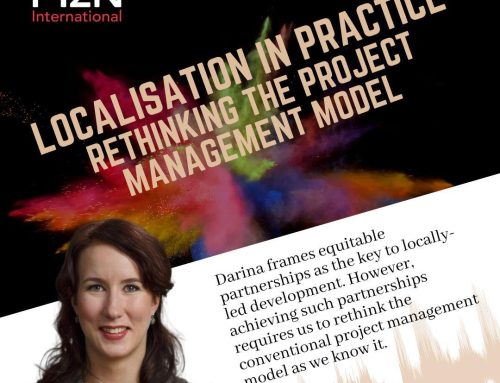In Part 1 of this two-part series, we discuss why your NGO should take action on climate change, regardless if it has a climate focus or not, and how you can lower your carbon footprint.
It is easy to see the role of certain NGOs in climate change: those with clearly aligned missions of environmental protection, disaster risk reduction, or clean energy. Others work in closely associated fields including agriculture or water resource management. But what if yours doesn’t? How can your (non-environmental) NGO help in the fight against climate change?
Even organisations without a climate mandate can respond to the climate crisis. To step up and ‘be the change we want to see’ is not only ethically the right thing to do, but donors across the sector are expecting it. Additionally, by taking action, we can help prepare our organisations for an uncertain future.
Here are some ideas on how climate change is relevant to your NGO and what you can do to respond to the climate emergency.
Our NGO already does good… do we have to be green as well?
NGOs are natural allies to the climate movement, positioned as knowledge managers, relationship brokers between government and private stakeholders, and community activists. Yet whichever sector we work in, the development gains we are striving for can be reversed in an instant when a disaster such as a flash flood or wildfire hits. They can also be eroded over time as slow-onset changes, such as desertification, land and sea temperature rise, or climate-driven urbanisation, become unmanageable.
Climate change will impact, or already is impacting, every one of us, the lives we touch, and all of the projects and campaigns we work on. Despite deep disparities across nations and sectors regarding who is responsible for much of the changing climate and environmental degradation, limiting it will require all of us to take action together. This is made evident in IPCC’s urgent call to action.
If the moral reason for going green is not enough, the business case for sustainability is irrefutable. A sustainable business model has been shown to increase staff loyalty, engagement and retention, and public support. And donors, staff, the public and other stakeholders increasingly expect the climate to be mainstreamed through our programmes. While many of us are already choosing greener options within our offices and operations, and reporting on our carbon footprints in Annual Reports, we believe that there is more that can be done. Here we give you some practical, affordable steps to take your NGO’s climate impact to the next level.
How to take lowering your carbon footprint to the next level
Many public, private and non-profit offices have taken steps to assess and reduce their carbon footprint and encourage eco-friendly options for their staff and office services. Advice abounds on staff engagement activities, carbon off-setting, recycling, cycling-to-work, conscientious catering and suppliers, and energy use in the office. My sympathy goes out to Procurement and Office Services teams in every HQ who have to balance decisions on eco-expectations with cost and reliability (having to politely decline the offer of dodgy second-hand furniture, for instance, or refusing to set up a canteen composter).
While acknowledging the steps taken at this level, there is so much more that can be done across any organisation which doesn’t have to cost the earth.
Use your corporate money wisely:
Consider ethical corporate banking, staff pension provision and investment management. Find renewable energy providers and suppliers for your offices – including your offices outside of the UK and Europe. Not only can your organisation’s money support sustainable investments and contribute to a lower carbon footprint, but it can help to comply with ethical supply chain requirements increasingly being asked of in the EU.
Reconsider your public fundraising operations:
If your organisation relies on paper direct mail and in-person events, think about how you might phase out such inefficient and resource-heavy practices. For many NGOs, their returns on investment are dropping as their marketing audience changes over time. Begin a real scale-up of your digital fundraising campaigns (see MzN’s webinar on this) and work on strengthening and diversifying your institutional income.
Don’t go there! Go digital:
We are experiencing a massive reduction in travel and an emergence of digital working models due to the Coronavirus. Some suggest remote working to be a permanent fixture. Yet to really engage, interact and learn from each other as a functioning online team, we need specialist training, tools and some shifts and allowances in the way we manage and oversee performance. To do this well takes an initial investment in digitalisation which will provide long-term returns and benefits.
Some of the most common reasons to (still) meet face-to-face are for people management, training and negotiating purposes, all of which we believe is not only possible – but often better and more efficient – online.
Managing a remote team: Though remotely managing a team seems difficult, it is possible. In fact, many organisations are committing to working 100% online and not retaining a physical office. Indeed, MzN International has been wholly remote since early 2018.
For a digital organisation to be successful, managers need to be outcome-focused and work within processes that allow remote oversight and decision-making. Consider specialist training, for example our fellow consultant Tosca from Five Oaks Consulting offers many tips on virtual team leadership (and a virtual team leadership course). It is also critical that everyone within your organisation knows how to use all the software and systems properly; otherwise you are asking for poor management, stress and ultimately bad performance.
Since 2011, we have helped our partners create more impact using digital technologies. We build digital capabilities to help our clients swap analogue ways of working for the benefits of digital ones. Find out more about our digital transformation services.
Online capacity-building: The days of flying HQ staff out to field offices to deliver safeguarding or M+E training should be over. It is worth investing in transferring your training online and ensuring your teams have the equipment they need. One UK-based NGO we work with, for instance, has a small Learning & Development team spread across their regions. This team prepares their staff to deliver or accompany trainings using a train-the-trainer method. Not only does this increase staff skills and infuse training with the local context, but it allows the organisation to train local partners in organisational policies to the same level as staff receive, which is increasingly important for donor compliance.
Negotiations: Take advantage of this moment when institutional donors, Boards, Councils and key stakeholders expect us to meet online instead of at expensive and carbon-intensive in-person meetings. Invest in creating those relationships remotely. One client, a human rights network with Council members in four time zones, has committed to never bringing their Council or huge AGM together again physically. They have rolled out other ways to engage the wider membership and hold every meeting online, saving thousands of dollars and tonnes of CO2.
Measure and offset the remaining CO2
Measure your organisation’s carbon footprint and offset whatever is left that you cannot reduce. There are many organisations that can help you assess and offset your carbon impact. MzN works with the organisation Generation Forest, for example, which takes environmental and climate action on our behalf, including planting trees in areas that need reforestation. It is wonderful to be able to say we are now a carbon neutral organisation. You can read about how we did it here.
We, the nonprofit sector, are a movement and a community in ourselves, and we can have a huge impact if we all pull in the same direction. Indeed, over 80 INGOs have already signed up to the InterAction-led NGO Climate Compact, pledging to do what they can to fight climate change together. We can grasp this challenge and look for ways to lower our carbon impact (mitigation), and create ways of living and working that anticipate and respond to the shifts that will come as a result of climate change (adaptation). For our organisations, adaptation means future-proofing both the solutions we deliver on the ground, as well as our internal processes and structures. Part of this responsibility includes building the climate resilience of those we work with, an integral part of all development work, which we will discuss in the second part of this series.





